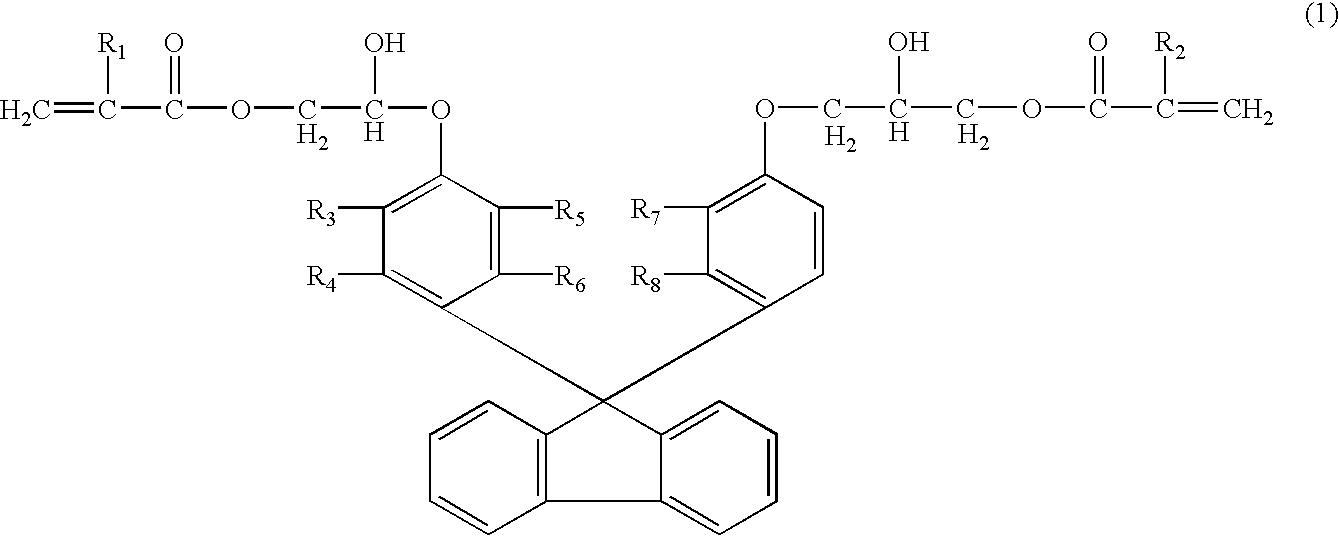Insulating resin composition and laminate obtained therefrom
a technology of insulation resin and composition, which is applied in the field of insulation resin, can solve the problems of resin composition not providing a sufficiently high peeling strength against a plating metal, the dispersed particles are still too large in diameter, and the coexistence of impact resistance and adhesiveness to the substrate cannot be realized
- Summary
- Abstract
- Description
- Claims
- Application Information
AI Technical Summary
Problems solved by technology
Method used
Image
Examples
synthetic example 1
[0057] In 300 -ml four-necked flask fitted with a reflux condenser were introduced 96.0 g of the FHPA solution, 14.4 g of BPDA, 2.5 g of PGMEA and 0.15 g of TEABr, the mixture was stirred at 120-125.degree. C. for 2 hours with stirring and further heated at 60-62.degree. C. for 8 hours with stirring to give a solution of carboxyl-containing copolymer A.
[0058] The evaluation of the resin solution thus obtained yielded the following results: solid content, 56.5 wt %; acid value (as solid), 90.3 mgKOH / g; area (%) of the carboxyl-containing copolymer in the resin solution determined by GPC, 90%; weight average molecular weight, 15,000.
synthetic example 2
[0059] In 300 -ml four-necked flask fitted with a reflux condenser were introduced 96.0 g of the FHPA solution, 10.8 g of BPDA, 5.6 g of THPA, 1.64 g of PGMEA and 0.15 g of TEABr, the mixture was stirred at 120-125.degree. C. for 2 hours with stirring and further heated at 60-62.degree. C. for 8 hours with stirring to give a solution of carboxyl-containing copolymer B.
[0060] The evaluation of the resin solution thus obtained yielded the following results: solid content, 56.5 wt %; acid value (as solid), 88.1 mgKOH / g; area (%) of the carboxyl-containing copolymer determined by GPC, 96%; weight average molecular weight, 5,400.
example 1
[0061] Preparation of Resin Composition
[0062] A resin composition solution was prepared by mixing 30 parts by weight each as solid of the solutions of carboxyl-containing copolymers A and B ( sum of 60 parts by weight), 12 parts by weight of trimethylolpropane triacrylate (TMPT) as an unsaturated compound, 7 parts by weight as solid of carboxyl-containing crosslinked rubber with an average particle diameter of 0.07 .mu.m (XER-91 as 15% dispersion in MEK with an acid value of 10.0 mgKOH / g, available from JSR Corporation) as a crosslinked elastic polymer, 2 parts by weight of 2-methyl-1-[4-(methylth-io)phenyl]-2-morpholinopropanone-1 as a photopolymerization initiator, 26 parts by weight of epoxy resin (Epikote 834 available from Yuka Shell Epoxy Co.,), 0.04 part by weight of a photosensitizer (EABF available from Hodogaya Chemical Co., Ltd.), 1.6 parts by weight of other additives and 100 parts by weight of ethyl acetate, agitating the mixture by an agitator for 1 hour to effect diss...
PUM
| Property | Measurement | Unit |
|---|---|---|
| average secondary particle diameter | aaaaa | aaaaa |
| average primary particle diameter | aaaaa | aaaaa |
| diameter | aaaaa | aaaaa |
Abstract
Description
Claims
Application Information
 Login to view more
Login to view more - R&D Engineer
- R&D Manager
- IP Professional
- Industry Leading Data Capabilities
- Powerful AI technology
- Patent DNA Extraction
Browse by: Latest US Patents, China's latest patents, Technical Efficacy Thesaurus, Application Domain, Technology Topic.
© 2024 PatSnap. All rights reserved.Legal|Privacy policy|Modern Slavery Act Transparency Statement|Sitemap

